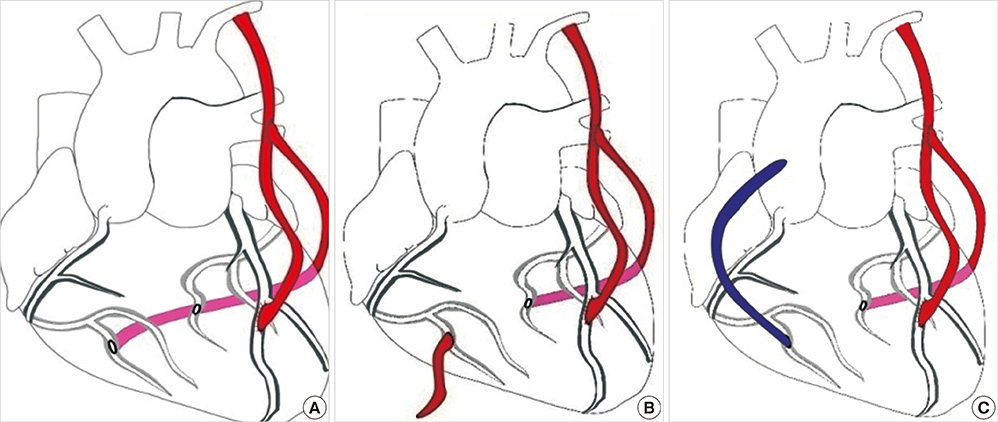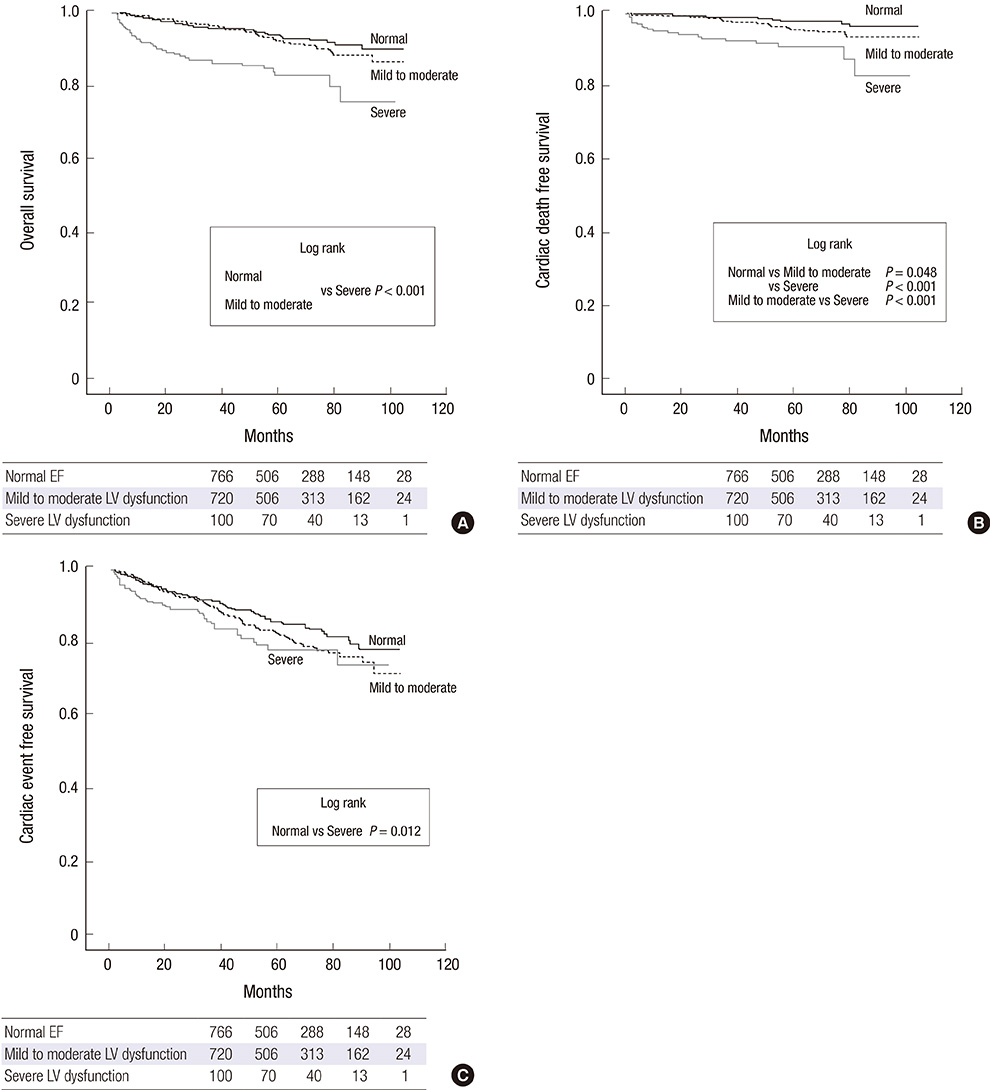J Korean Med Sci.
2014 Jan;29(1):69-75. 10.3346/jkms.2014.29.1.69.
Outcomes of Off-Pump Coronary Bypass Grafting with the Bilateral Internal Thoracic Artery for Left Ventricular Dysfunction
- Affiliations
-
- 1Department of Thoracic and Cardiovascular Surgery, Samsung Medical Center, Sungkyunkwan University School of Medicine, Seoul, Korea. opheart1@gmail.com
- 2Department of Thoracic and Cardiovascular Surgery, Seoul Adventist Hospital, Seoul, Korea.
- KMID: 1796917
- DOI: http://doi.org/10.3346/jkms.2014.29.1.69
Abstract
- This study evaluated the outcomes of off-pump coronary artery bypass surgery (OPCAB) with severe left ventricular dysfunction using composite bilateral internal thoracic artery grafting. From January 2001 to December 2008, 1,842 patients underwent primary isolated OPCAB with composite bilateral internal thoracic artery grafting. A total of 131 of these patients were diagnosed with a severely depressed preoperative left ventricle ejection fraction (LVEF) (< or =0.35). These patient outcomes were compared with the outcomes of 830 patients that had mildly or moderately depressed LVEF (0.36 to 0.59) and 881 patients with normal LVEF (>0.6). The early mortality for patients with severe LVEF was 2.3%. The 3-yr and 7-yr survival rate for patients with severe LV dysfunction was 86.0% and 82.8%, respectively. Multivariate analysis showed that severe LV dysfunction EF increased the risk of all-cause death (P=0.012; hazard ratio [HR],2.14; 95% confidence interval [CI],1.19-3.88) and the risk of cardiac-related death (P=0.008; HR,3.38; 95% CI, 1.37-8.341). The study identified positive surgical outcomes of OPCAB, although severe LVEF was associated with two-fold increase in mortality risk compared with patients who had normal LVEF.
MeSH Terms
Figure
Reference
-
1. Goldstein DJ, Beauford RB, Luk B, Karanam R, Prendergast T, Sardari F, Burns P, Saunders C. Multivessel off-pump revascularization in patients with severe left ventricular dysfunction. Eur J Cardiothorac Surg. 2003; 24:72–80.2. Pande S, Agarwal SK, Kundu A, Kale N, Chaudhary A, Dhir U. Off-pump coronary artery bypass in severe left ventricular dysfunction. Asian Cardiovasc Thorac Ann. 2009; 17:54–58.3. Lytle BW, Blackstone EH, Sabik JF, Houghtaling P, Loop FD, Cosgrove DM. The effect of bilateral internal thoracic artery grafting on survival during 20 postoperative years. Ann Thorac Surg. 2004; 78:2005–2012.4. Endo M, Nishida H, Tomizawa Y, Kasanuki H. Benefit of bilateral over single internal mammary artery grafts for multiple coronary artery bypass grafting. Circulation. 2001; 104:2164–2170.5. Kim WS, Lee J, Lee YT, Sung K, Yang JH, Jun TG, Park PW. Total arterial revascularization in triple-vessel disease with off-pump and aortic no-touch technique. Ann Thorac Surg. 2008; 86:1861–1865.6. Akins CW, Boucher CA, Pohost GM. Preservation of interventricular septal function in patients having coronary artery bypass grafts without cardiopulmonary bypass. Am Heart J. 1984; 107:304–309.7. Gioia G, Matthai W, Gillin K, Dralle J, Benassi A, Gioia MF, White J. Revascularization in severe left ventricular dysfunction: outcome comparison of drug-eluting stent implantation versus coronary artery by-pass grafting. Catheter Cardiovasc Interv. 2007; 70:26–33.8. Herz I, Moshkovitz Y, Loberman D, Uretzky G, Braunstein R, Hendler A, Zivi E, Ben-Gal Y, Mohr R. Drug-eluting stents versus bilateral internal thoracic grafting for multivessel coronary disease. Ann Thorac Surg. 2005; 80:2086–2090.9. Jegaden O, Bontemps L, de Gevigney G, Eker A, Montagna P, Chatel C, Itti R, Mikaeloff P. Does the extended use of arterial grafts compromise the myocardial recovery after coronary artery bypass grafting in left ventricular dysfunction? Eur J Cardiothorac Surg. 1998; 14:353–359.10. Deja MA, Woś S, Gołba KS, Zurek P, Domaradzki W, Bachowski R, Spyt TJ. Intraoperative and laboratory evaluation of skeletonized versus pedicled internal thoracic artery. Ann Thorac Surg. 1999; 68:2164–2168.11. Ahmed WA, Tully PJ, Baker RA, Knight JL. Survival after isolated coronary artery bypass grafting in patients with severe left ventricular dysfunction. Ann Thorac Surg. 2009; 87:1106–1112.12. Jones RH, Velazquez EJ, Michler RE, Sopko G, Oh JK, O'Connor CM, Hill JA, Menicanti L, Sadowski Z, Desvigne-Nickens P, et al. Coronary bypass surgery with or without surgical ventricular reconstruction. N Engl J Med. 2009; 360:1705–1717.13. Nardi P, Pellegrino A, Scafuri A, Colella D, Bassano C, Polisca P, Chiariello L. Long-term outcome of coronary artery bypass grafting in patients with left ventricular dysfunction. Ann Thorac Surg. 2009; 87:1401–1407.14. Pevni D, Uretzky G, Mohr A, Braunstein R, Kramer A, Paz Y, Shapira I, Mohr R. Routine use of bilateral skeletonized internal thoracic artery grafting: long-term results. Circulation. 2008; 118:705–712.15. Agrifoglio M, Trezzi M, Barili F, Dainese L, Cheema FH, Topkara VK, Ghislandi C, Parolari A, Polvani G, Alamanni F, et al. Double vs single internal thoracic artery harvesting in diabetic patients: role in perioperative infection rate. J Cardiothorac Surg. 2008; 3:35.16. Momin AU, Deshpande R, Potts J, El-Gamel A, Marrinan MT, Omigie J, Desai JB. Incidence of sternal infection in diabetic patients undergoing bilateral internal thoracic artery grafting. Ann Thorac Surg. 2005; 80:1765–1772.17. Gupta S, Pressman GS, Fiqueredo VM. Incidence of, predictors for, and mortality associated with malignant ventricular arrhythmias in non-ST elevation myocardial infarction patients. Coron Artery Dis. 2010; 21:460–465.18. Hillis GS, Zehr KJ, Williams AW, Schaff HV, Orzulak TA, Daly RC, Mullany CJ, Rodeheffer RJ, Oh JK. Outcome of patients with low ejection fraction undergoing coronary artery bypass grafting: renal function and mortality after 3.8 years. Circulation. 2006; 114:I414–I419.19. Filsoufi F, Rahmanian PB, Castillo JG, Chikwe J, Kini AS, Adams DH. Results and predictors of early and late outcome of coronary artery bypass grafting in patients with severely depressed left ventricular function. Ann Thorac Surg. 2007; 84:808–816.20. Lee YT, Park KH. Characteristic and harvesting technique of bypass conduits: concise coronary artery bypass. 1st ed. Seoul: Korea Medical Book Publicher;2008. p. 50–51.
- Full Text Links
- Actions
-
Cited
- CITED
-
- Close
- Share
- Similar articles
-
- Right Heart Support in OPCAB: 2 cases Report
- Wrapping of an Ascending Aortic Aneurysm with the Multiple Boot-Straps Technique in a Patient Undergoing Off-Pump Coronary Artery Bypass Grafting
- The Comparison Study of Early and Midterm Clinical Outcome of Off-Pump versus On-Pump Coronary Artery Bypass Grafting in Patients with Severe Left Ventricular Dysfunction (LVEF< or =35%)
- Hybrid Coronary Artery Revascularization for Takayasu Arteritis with Major Visceral Collateral Circulation from the Left Internal Thoracic Artery
- Graft Strategy for Coronary Artery Bypass Grafting in Patients with Severe Left Ventricular Dysfunction




